By
Published
November 23, 2021
Tags
Declining workforce participation. Increased unpaid caregiving burdens. Rising domestic violence rates. Over the past two years, women and girls have disproportionately suffered from the consequences of COVID-19. Additionally, growing attacks on abortion rights threaten to undercut hard-fought advances in gender and reproductive equity.
Organizations in the U.S. and around the world are scrambling to reverse these setbacks, but they do not have enough funding to meet the need. While women and girls make up 50% of the world’s population, only 1.9% of all charitable dollars are donated to organizations focused on advancing their health, safety and rights.
This situation is unacceptable, and I believe we can—and must—change things for the better. Investing in women and girls is both an urgent need and an investment in improving all of humanity. We can each do our part by contributing to organizations that support, empower and improve the lives of women and girls in the U.S. and globally.
The Need Today for Investing in Women and Girls
Society has long undervalued women’s contributions and freedoms and has overlooked gender-based violence and harm. Since the pandemic hit, these inequities have only magnified.
For example, while recent headlines trumpet a labor shortage, the real picture is far more complicated and uneven. Women were significantly more likely than men to lose their jobs due to the pandemic, and many more had to put their careers on hold when schools, daycares, and other services closed. According to the National Women’s Law Center, women account for 57.3% of job losses since February 2020, and U.S. women’s employment rates may not recover until 2024, a full two years after a full recovery is projected for men’s employment.
And these statistics are just for paid labor. Pre-pandemic, women were already performing three times more unpaid care work than men. Once the pandemic hit, they faced even more pressure to balance work, childcare, homeschooling, caring for older or sick family members and maintaining their homes. As of last month, over 1.7 million women have left the labor force for more than six months since the start of the pandemic. This impact is unequally prevalent for Black women and Latinas, with one in 14 Black women and one in 17 Latinas unemployed.
Women are also facing attacks on their safety and bodily autonomy. Pre-pandemic, one in four women and one in ten men in the U.S. had experienced intimate partner violence. Extended lockdowns and quarantine periods due to the pandemic have only exacerbated rates of domestic violence. Meanwhile, women’s health and reproductive rights are under attack in the U.S, which has serious implications for women’s ability to control their bodies, lives and destinies. This is especially true for low-income women and women of color.
These consequences of the pandemic have created daunting challenges for women. Trends in giving lead me to worry that unless we significantly increase our investments in women and girls, these setbacks will continue to have long-term effects. Charitable dollars towards women and girls increased only 0.3% over the past five years. While this level of growth was already inadequate, we cannot allow it to remain as stagnant given the vast need women face today.
We must view contributions towards women and girls as urgent and essential investments. Now is the time to give—and give big.
The Investment Gap
While women are most directly impacted by recent setbacks, all of us are affected. Research spanning decades and countries proves that businesses are more profitable, governments are more effective and communities are healthier when women have a seat at the table and our rights and voices are respected equally. Yet, the fraction of charitable dollars currently directed towards women and girls does not correlate with the positive impact of women's success on our world.
This underinvestment can be partially explained by the fact that men still control most of the money and decision-making power, both in government and business. While all of us benefit when women thrive, men are much less likely to invest in gender equity as they do not bear the brunt of the burdens that women and girls face on a day-to-day basis.
The power balance is shifting, though. Women control a growing share of the world’s wealth, and with that comes a growing share of decision-making power over charitable giving. As women and a more diverse range of people gain wealth, they have the ability to step up and support organizations that advance women and girls much more significantly and shift the trends of charitable giving in the field.
Importantly, a person does not have to be a billionaire—or even have substantial means—to be a philanthropist who can make a major difference. Every dollar towards women and girls is a step towards strengthening the economic and social fabric of our communities, and we each have the responsibility to give what we can.
Where to Give
So, where should you give? Thankfully, there is no shortage of organizations working to build a world where all women have political and economic power, freedom over their bodies, and safety in all aspects of their lives.
To find potential organizations to support, I recommend learning about the featured grantees in Schusterman Family Philanthropies’ Gender and Reproductive Equity portfolio. These organizations are doing groundbreaking work to help women in the U.S. and across the globe achieve political power and leadership, foster economic independence and mobility, combat violence and harassment, and preserve reproductive freedom. I sincerely hope that more donors, large and small, will join us in investing in their efforts.
I also recommend exploring the Idea Lab, hosted by the Equality Can’t Wait Challenge. The Equality Can’t Wait Challenge was a grant competition to support bold solutions to accelerate gender equality in the United States, and six projects ultimately received $40 million in funding through the support of Melinda Gates’ Pivotal Ventures, Schusterman Family Philanthropies, and MacKenzie Scott and Dan Jewett. Because there were so many compelling submissions, the Challenge established an online Idea Lab to showcase the top 50 entries. These projects are prepared to tackle the most pressing barriers facing women today, and they welcome opportunities to scale their efforts.
These are just a few examples of organizations leading the critical work of advancing gender equity, and you can also learn about local efforts to support right in your own community. The bottom line is to give generously now to help reverse the setbacks for women as quickly as possible and help our families, businesses and societies thrive long-term.
No matter where you decide to give or what amount you contribute, your investment in women and girls today ensures that all of us can live with greater equity, safety and dignity in the years ahead.
Learn more about Schusterman’s Gender and Reproductive Equity portfolio.






